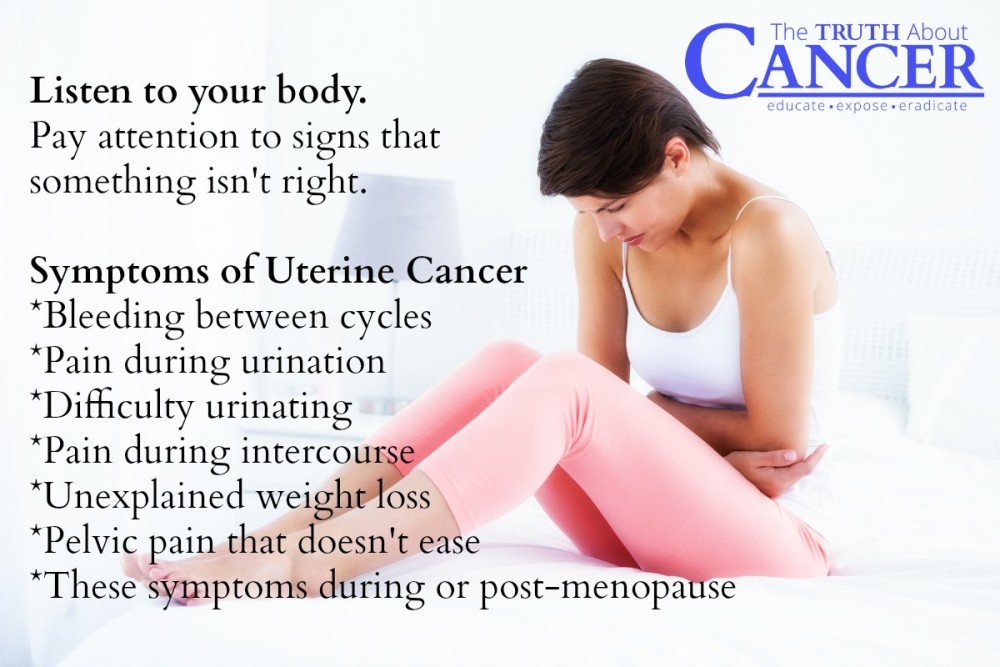The uterus or womb is part of the female reproductive system. It is a hollow, pear-shaped organ lined with glandular tissue labeled endometrium. The lower portion of the uterus, the cervix, leads to the vaginal canal.
Cancer of the uterus is typically diagnosed in women who are post-menopausal, 50-60 years of age and impacts the lives of nearly 50,000 women in the United States alone each year.
Symptoms of Uterine Cancer
- Vaginal bleeding or discharge (could be red, pink, or white) during or post-menopause
- Bleeding or spotting between menstrual cycles
- Pain or difficulty during urination
- Discomfort or pain during intercourse
- Unknown weight loss
- Pelvic pain
Uterine cancer is the most commonly diagnosed malignancy of the female reproductive system. As with all forms of cancer, regular screening increases your chance of early detection and cure (though oncologists don’t like to use the word “cure”).
What is Uterine Cancer?
Abnormal cells in the uterus may be non-cancerous, pre-cancerous, or cancerous. If they have the ability to spread to other organs of the body, they are considered cancerous (malignant).
Endometrioid carcinoma (endometrial cancer) represents almost 95% of all diagnosed cases. It is the development of cancer cells in the lining of the uterus. These cells can spread to the surrounding nerves and blood vessels or metastasize to organs such as the liver, lungs, and bones. If it is caught early, the survival rate is high.
Clear cell adenocarcinoma is usually found in women who were exposed to diethylstilbestrol (DES), a pharmaceutical estrogen, prior to birth. It was prescribed by doctors from 1938 to 1971 to prevent miscarriages in pregnant women. Women affected by DES have a higher risk of vaginal, cervical, and uterine cancers. Furthermore, these cancers are more likely to be aggressively metastatic in nature.
Rarer forms of uterine cancer that are also aggressive and tend to utilize the lymphatic system to metastasize include: Uterine sarcoma (develops in the connective tissue or muscle cells of the uterus), Adenosquamous carcinoma (which forms on the outside of the uterus), and Carcinomasarcoma (also begins in the endometrium).
Uterine Cancer Risk Factors
- Age: The average age that women are diagnosed with uterine cancer is 60.
- Obesity: Having a body mass index (BMI) over 30% leads to excessive estrogen production. Obesity is linked to more than 40% of all uterine cancer cases.
- Race: Caucasian women are diagnosed with uterine cancer most often.
- Family History: As many as 5% of women diagnosed with uterine cancer also have Lynch Syndrome (a form of colorectal cancer) in their families. Genetic testing is advisable and early screening is critical.
- Personal History: Patients recovering from breast, colorectal, or ovarian cancer have a higher risk of developing uterine cancer. Radiation therapy and certain breast cancer drugs may also increase your risk.
- Estrogen: Long term exposure to hormonal birth control or hormone replacement therapy (post menopause) have a higher risk of reproductive system cancers, including cancer of the uterus.
- Other Factors: Diabetes, endometrial hyperplasia (thickening of the uterine lining), early menstruation (before age 12), delayed menopause (after age 55) and abnormal menstrual cycles can all impact your risk of uterine cancer.
Certain risk factors are common amongst all forms of cancer and in both genders. Prevention through the adoption of a healthy lifestyle lowers your risk of cancer and other serious diseases by more than half, according to experts.
Early Screening is Critical
Annual appointments for one or more of the following tests are recommended to maintain uterine health. Always tell your doctor if you are experiencing any unusual symptoms.
- Pap Test: Cells from your cervix and upper portion of your vagina are collected. These cells undergo pathological examination to determine if cancerous cells have developed. If abnormal cells are present, your doctor may perform a biopsy (collection of tissue) to accurately identify them. However, if there is cancer, biopsies can spread the cancer into the bloodstream, so this is not a diagnostic tool that we recommend.
- Trans-vaginal Ultrasound: An instrument is inserted in the vagina, which releases sound waves to create a picture of the uterus to assist the physician in determining the actual health of your uterus.
- Pelvic Exam: An instrument is inserted into the vagina and cervix, to examine the uterus, bladder, vagina, and rectum. If lumps are observed in these organs, a biopsy is performed to determine their status. Again, I want to reiterated that biopsies can spread the cancer into the bloodstream, so this is not a diagnostic tool that we recommend.
Preventing Cancer Before It Starts
Cancer is preventable and curable.
Every single day, tens of thousands of people, just like you, are stopping cancer (and/or preventing it) from destroying their bodies and taking their lives!
It’s time to take matters into our own hands, to be proactive in the fight against cancer; to educate ourselves about real prevention and treatments that work, whether they are part of the mainstream practices or not.
Remember… the power to heal is yours!




















????????????????????????✝☮????✝ I watched all the TTAC episodes and learned so much! I actually took some notes to look up info and learn more on my own. Thank you Ty for such an informative honest and amazing series!! It encouraged me to continue on with my new attitude and direction of eating and loving healthier foods and especially adding spices to my diet as well!! I look forward to continued reading from your discoveries and knowledge. Thank you again!
Respectfully
Donna L Meade
So, what do you do, if you say NO, to a biopsy?
Hi Rita –
Here’s an article we have which discusses alternatives to a biopsy:
https://thetruthaboutcancer.com/breast-lumpectomy-biopsy/
Please note that if you would have to have individualized medical advice, he best advice we can give you is to consult with one of the doctors we interviewed in the Global series.
Please note that we are not able to select an expert for you.
We’ve created a page with the experts’ contact info as it was available to us.
Here’s the link to the actual webpage:
http://thetruthaboutcancer.com/experts-info-sheet/
We do have one more resource you may be interested in. During our Live Event 2017 series, Dr. Patrick Quillin suggested contacting The Institute of Functional Medicine to locate a practitioner in your area.
If you are interested, here is the link to search for a Functional Medicine Practitioner in your area: https://www.ifm.org/find-a-practitioner/
Hope this is helpful! Blessings and love!
Are there any natural treatments known to help uterine cancer?
As with Rita and Regina I also want to know the alternative biopsy and treatment for uterine/endometrial cancer
I had a D&C~I refused an office biopsy. Had endometrial cancer and then had a hysterectomy.
Who to contact about vulvular cancer???
Go to YouTube and search for “the truth about cancer” or the whole series called “the quest for the cure” hosted by Ty Bollinger. Fantastic documentary series and it will tell you your options to biopsies, and natural proven treatments. Every question you have will be answered!
Who at Truth about cancer can I talk to or anyone else know what specific natural cures, treatments, doctors clinics have worked with Uterine Leiomyosarcoma? I have bought all the episodes… so much info I am dizzy, where to start. My sister in law has agreed to chemotherapy starting as early as next week as a preventative for spots on the lungs( undiagnosed) after hysterectomy was performed in past month.
I want to offer her easy to access options that are specific to her cancer, and a doctor to get a consult.
Any and all guidance greatly appreciated.
How can I find the answer to Satya Roinsons question ? We are being pressured to have chemo/radiation therapy now. What do we do.?
Do u know if a D & C is ok for an endometrial biopsy since they say biopsies can spread cancer? My dr says my lining is thicker than what it should be . She wants to use the pipelle spoon-like tool that’ cuts a sample of the lining & wipe out any remaining blood of the lining. My doctor claims she’s not scraping deep so there shouldn’t be a concern about spreading cancer. My procedure is in 3 weeks so any help would be appreciated. Thks.